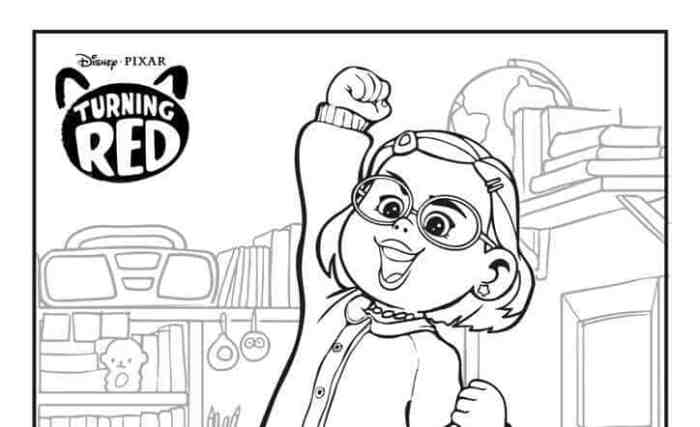Turning Red Color Pages A Multifaceted Exploration
The Phenomenon of “Turning Red Color Pages”

Turning red color pages – The sudden transformation of pages from their original color to a vibrant red carries a striking visual and emotional impact. This unexpected shift immediately draws attention, creating a sense of urgency, alarm, or even mystery, depending on the context. The effect is amplified by the inherent association of red with strong emotions like anger, danger, and passion. The specific emotional response will be heavily influenced by the surrounding narrative and the viewer’s pre-existing associations with the color.The color red, in this context, can symbolize a variety of things.
It might represent a character’s escalating anger or frustration, a critical plot point, a warning of impending danger, or even a metaphorical shift in the narrative’s tone or direction. The redness could also be a visual representation of a character’s inner turmoil, a physical manifestation of their emotional state bleeding onto the page, or a supernatural occurrence with deeper symbolic meaning.
The interpretation is ultimately dependent on the specific narrative and the creative choices of the author or designer.
Contexts for Red-Tinted Pages
The phenomenon of pages turning red can occur in a surprising number of contexts. In books, it might be used as a stylistic choice to emphasize a particularly intense or emotional scene, perhaps foreshadowing a crucial event or highlighting a character’s internal struggle. Imagine a historical novel where the pages depicting a violent battle turn red, mirroring the bloodshed described in the text.
In websites, this could be implemented as a visual cue, alerting users to critical errors, urgent updates, or security warnings. For example, a banking website might turn its transaction pages red if it detects fraudulent activity. Similarly, software applications could utilize this technique to signal errors or highlight areas requiring immediate attention, making it easier for users to identify and resolve problems.
Fictional Scene Illustrating Red Pages
Elara traced the faded ink of the ancient prophecy, her breath catching in her throat. The words, once a comforting sepia, pulsed with a growing crimson light. The parchment itself began to bleed a deep, alarming red, the color spreading from the edges inwards like a wildfire. The room seemed to grow colder as the vibrant red consumed the page, the prophecy’s words twisting and morphing before her eyes.
The change wasn’t merely visual; it was accompanied by a low, guttural hum that vibrated through her bones. The air crackled with an unseen energy, and Elara knew, with a chilling certainty, that the prophecy was not simply being revealed—it was being enacted. The crimson glow intensified, mirroring the growing fear in her heart.
The vibrant reds used in some coloring books are truly captivating, especially when you consider the range of hues possible. For a different kind of artistic challenge, consider exploring the intricate details offered by realistic dinosaur coloring pages , which can also feature rich reds in scales and landscapes. Returning to the initial point, the intensity of the red color page really depends on the quality of the crayons or markers used.
Technical Aspects of Red Color Page Transitions

This section delves into the technical methods used to achieve red color page transitions in digital environments, focusing on CSS and JavaScript techniques. We’ll examine various approaches, comparing their smoothness and visual impact, and providing illustrative code examples to clarify the implementation process.
Achieving a smooth transition to red requires manipulating the page’s background color or individual elements. This can be done through CSS transitions or JavaScript animation libraries, each offering unique advantages and disadvantages.
CSS Transitions for Red Color Changes
CSS transitions provide a simple and efficient way to animate CSS properties over a specified duration. To change a page’s background color to red smoothly, you can utilize the `transition` property. The following code snippet demonstrates a transition lasting one second:
.page
background-color: blue; /* Initial color
-/
transition: background-color 1s ease; /* Transition property
-/
.page.red
background-color: red; /* Target color
-/
In this example, the class “red” is added to the element with the class “page” to trigger the transition. The `ease` timing function provides a smooth transition; other functions like `linear` or `ease-in-out` can be used to alter the animation curve.
JavaScript-based Red Color Transition, Turning red color pages
JavaScript offers greater control over the transition process, allowing for more complex animations. The following code uses JavaScript to change the background color gradually:
let page = document.querySelector('.page');
let targetColor = 'red';
function changeColor(element, targetColor)
let currentColor = window.getComputedStyle(element).backgroundColor;
let r1 = parseInt(currentColor.substring(4, 6), 16);
let g1 = parseInt(currentColor.substring(8, 10), 16);
let b1 = parseInt(currentColor.substring(12, 14), 16);
let r2 = parseInt(targetColor.substring(1,3),16);
let g2 = parseInt(targetColor.substring(3,5),16);
let b2 = parseInt(targetColor.substring(5,7),16);
let steps = 10; // Number of steps for the transition
let dr = (r2 - r1) / steps;
let dg = (g2 - g1) / steps;
let db = (b2 - b1) / steps;
for (let i = 1; i
let r = Math.round(r1 + dr
- i);
let g = Math.round(g1 + dg
- i);
let b = Math.round(b1 + db
- i);
element.style.backgroundColor = '#' + ((1 << 24) + (r << 16) + (g <
changeColor(page, '#ff0000'); //'#ff0000' represents red in hex code
);
This JavaScript function iteratively changes the background color, creating a smoother visual effect than a simple CSS transition. The speed of the transition can be adjusted by modifying the `steps` variable and the timeout delay.
User Interface Element with Red Color Change
This example demonstrates a button that changes the page’s background color to red on click:
<button id="myButton">Turn Red</button>
<div class="page"></div>
<style>
.page
background-color: blue;
width: 100%;
height: 100vh;
transition: background-color 1s ease;
.page.red
background-color: red;
</style>
<script>
document.getElementById('myButton').addEventListener('click', () =>
document.querySelector('.page').classList.add('red');
);
</script>
This code uses a button to trigger the CSS transition. Clicking the button adds the "red" class to the page, causing the background color to change smoothly.
Comparison of Red Color Transition Methods
Different methods offer varying levels of control and visual effects.
| Method | Speed Control | Visual Effect | Complexity |
|---|---|---|---|
| CSS Transition | Limited, controlled by transition duration | Smooth, predefined easing functions | Low |
| JavaScript Animation | High, granular control over each step | Highly customizable, can create complex effects | High |
| CSS Animation | Moderate, using keyframes | Smooth, can create complex effects with keyframes | Medium |
Cultural and Artistic Interpretations: Turning Red Color Pages
The phenomenon of pages turning red, while seemingly simple, lends itself to rich cultural and artistic interpretations. The shift in color from the expected to the unexpected carries symbolic weight, capable of evoking a range of emotions and conveying complex narratives. Examining this through various lenses – literary, psychological, and artistic – reveals the multifaceted nature of this visual metaphor.The sudden blush of red across pages suggests a potent transformation, a shift from the ordinary to the extraordinary.
This visual disruption can be interpreted in several ways, depending on the context.
Examples in Literature and Film
The use of color as a symbolic device is prevalent throughout literature and film. For instance, in the classic novelThe Great Gatsby*, F. Scott Fitzgerald uses the color green to symbolize Gatsby's unattainable dream. While not directly red pages, the concept of a significant color shift mirroring an internal or external change is similar. Similarly, in many horror films, a sudden shift to a red hue often signals violence or danger.
The red color itself carries connotations of blood, passion, anger, and even warning. Consider the use of red lighting in suspenseful scenes; it heightens the tension and foreshadows impending events. The visual impact is akin to seeing pages turn red—a jarring shift that alters the viewer's perception and expectation.
Psychological Implications of Red Pages
The psychological impact of witnessing pages turn red is likely multifaceted. The unexpected color change could trigger a physiological response, possibly increasing heart rate and inducing feelings of anxiety or surprise. Depending on the context, it could be interpreted as a sign of danger, passion, or even a manifestation of a character's internal emotional state. The sudden shift could be unsettling, representing a loss of control or a disruption of the expected narrative flow.
Conversely, it could also represent a powerful moment of transformation or revelation. Consider the emotional impact of seeing a character's diary pages turn red as they experience a moment of intense emotion – it visually reinforces the character's internal turmoil.
Artistic Styles for Depicting Red Pages
Several artistic styles could effectively capture the phenomenon of pages turning red. A hyperrealistic approach could meticulously detail the texture of the paper and the precise gradation of the red hue, emphasizing the physicality of the transformation. Conversely, an expressionistic style could exaggerate the color, using bold strokes and vibrant shades to convey the emotional intensity of the event.
A surrealist approach might depict the red pages as a dreamlike or hallucinatory experience, blurring the lines between reality and fantasy. Finally, a minimalist style could focus on the stark contrast between the red pages and their surroundings, highlighting the unexpectedness of the change.
Poem Inspired by Red Pages
Crimson tide, across the page it flows,Ink bleeds scarlet, a silent, burning rose.Whispers turn to shouts, a story's sudden sway,From muted grey to fiery red, it holds the day.The words ignite, a passion uncontrolled,A tale unfolds, in colors brave and bold.
Practical Applications and Examples

The phenomenon of a rapid, attention-grabbing color change, particularly to red, finds significant utility across diverse applications, leveraging the inherent psychological impact of the color red to signal urgency and importance. This section explores practical examples and designs illustrating the effective implementation of red color page transitions in various contexts.
The use of red as a warning signal is deeply ingrained in our collective understanding. It’s a universally recognized indicator of danger or immediate action required, stemming from its association with fire, blood, and other inherently hazardous situations. This innate response makes it a powerful tool in designing effective visual warnings.
Real-World Applications of Red Color Change Signals
Red color changes are prevalent in numerous real-world scenarios to communicate critical information quickly and efficiently. Consider the following examples:
- Traffic Signals: The universally recognized red light at intersections immediately signals drivers to stop, preventing accidents. The immediate visual impact of the red light is crucial for safety.
- Emergency Vehicle Lights: Ambulances, fire trucks, and police cars utilize flashing red lights to alert others of an emergency situation, demanding immediate attention and right-of-way.
- High-Temperature Alarms: Industrial machinery often incorporates red warning lights or displays to signal overheating, prompting immediate action to prevent damage or injury.
- Low-Battery Indicators: Many electronic devices use a red indicator to signal critically low battery power, prompting users to charge the device to avoid power failure.
Emergency Notification System Design
The following HTML code illustrates a simple user interface for an emergency notification system using a red color page transition:
<div id="notification" style="display:none; position:fixed; top:0; left:0; width:100%; height:100%; background-color:rgba(255,0,0,0.8); z-index:1000;">
<h1 style="color:white; text-align:center; padding-top:25%; font-size:3em;">EMERGENCY!</h1>
<p style="color:white; text-align:center; font-size:1.5em;"><span id="emergencyMessage">System Failure</span></p>
</div>
<script>
function triggerEmergency()
document.getElementById("notification").style.display = "block";
document.getElementById("emergencyMessage").textContent = "Immediate action required!";
</script>
This code creates a red overlay that covers the entire screen when the `triggerEmergency()` function is called. The message displayed can be customized. This example demonstrates a simple, but highly effective, method of using a red color transition to convey urgent information.
Red Color Page Transition in Different UI Designs
The implementation of a red color page transition can vary significantly depending on the user interface design. In a minimalist design, a simple color change might suffice. More complex interfaces might incorporate animations or transitions to enhance the visual impact. For instance, a gradual fade to red could create a sense of urgency building up, while a sudden, jarring change could be more shocking and attention-grabbing.
The specific choice depends on the desired level of impact and the overall design aesthetic.
Color Psychology in Red Page Transition Design
The effectiveness of a red color page transition hinges heavily on the principles of color psychology. Red is inherently associated with urgency, danger, and excitement. Using this knowledge, designers can leverage the emotional response to red to create effective warnings. A well-designed red transition should not be overly aggressive or distracting but should grab the user's attention without causing undue stress or anxiety.
The intensity of the red, the duration of the transition, and the accompanying message all contribute to the overall impact and effectiveness of the visual cue.
The Red Color's Symbolic Weight
Red, a vibrant and powerful hue, carries a profound symbolic weight that varies significantly across cultures and contexts. Its meaning is not static; instead, it's a fluid concept shaped by historical, religious, and social factors, as well as the specific shade and intensity of the red itself. Understanding these nuances is crucial to appreciating the multifaceted impact of red color page transitions.
The symbolic meaning of red is far from universal. While often associated with passion and energy, its connotations can shift dramatically depending on cultural background. For example, in many Western cultures, red signifies love, excitement, and danger, while in some Eastern cultures, it represents good fortune, prosperity, and celebration. This divergence highlights the importance of considering cultural context when interpreting the symbolism embedded within a red color page transition.
Cultural Variations in the Symbolism of Red
Red's symbolic meaning varies considerably across different cultures. In Western cultures, red is frequently linked to concepts such as passion, love, danger, and aggression. Think of the red heart symbolizing romantic love, or the red stop sign signaling immediate danger. However, in some Asian cultures, red is strongly associated with good luck, prosperity, and happiness. Traditional Chinese weddings often feature extensive use of red, reflecting its positive connotations in that cultural context.
Similarly, in many African cultures, red can represent strength, power, and spiritual significance. These diverse interpretations demonstrate the complex and multifaceted nature of red's symbolic meaning.
The Influence of Red's Intensity on Interpretation
The intensity of the red color significantly influences its interpretation. A deep, crimson red might evoke feelings of power, intensity, and even anger, while a lighter, pinkish red might suggest gentleness, romance, or even innocence. A fiery scarlet can convey urgency and excitement, whereas a muted burgundy might convey sophistication or seriousness. These subtle shifts in hue can dramatically alter the emotional response elicited by the color.
For example, a website using a deep crimson red for its call-to-action button might convey a sense of urgency and importance, while a softer pink might be used for a more gentle, less intrusive call to action.
The Effect of Lighting on Red Color Transitions
Lighting conditions dramatically affect the perception of red color transitions. A brightly lit red page might appear vibrant and intense, while the same page in dim lighting could appear darker and more muted, potentially altering the overall emotional impact. Warm lighting can enhance the richness of the red, while cool lighting might make it appear colder or less saturated.
Consider, for example, a dramatic scene transition in a film: a red-tinged scene viewed in a dark theater will have a significantly different impact than the same scene viewed on a brightly lit screen. The interplay between lighting and color significantly shapes the viewer's experience.
Connotations of Red Across Different Contexts
The following list summarizes various connotations associated with the color red across diverse contexts:
- Passion and Love: Romantic love, desire, intimacy.
- Danger and Warning: Stop signs, fire alarms, emergency vehicles.
- Energy and Excitement: Sports teams, fast cars, vibrant celebrations.
- Power and Authority: Royal robes, military uniforms, political symbols.
- Good Fortune and Prosperity: Traditional Chinese and some African cultures.
- Aggression and Anger: Red faces expressing anger, violent imagery.
- Heat and Warmth: Fire, sun, warmth.
- Sacrifice and Martyrdom: Religious iconography in some traditions.





















